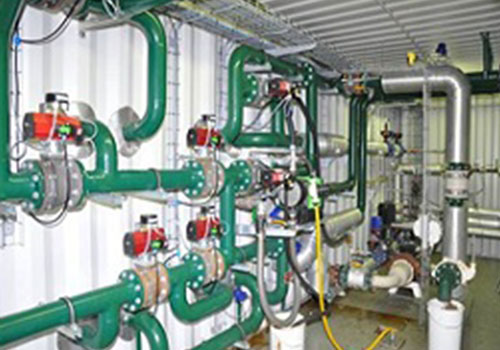Online Flow monitoring System
Online Flow monitoring System

Online Flow monitoring System
Magnetic flowmeters measure the velocity of conductive liquids in pipes, such as water, acids, caustic, and slurries. Magnetic flowmeters can measure properly when the electrical conductivity of the liquid is greater than approximately 5μS/cm. Be careful because using magnetic flowmeters on fluids with low conductivity, such as deionized water, boiler feed water, or hydrocarbons, can cause the flowmeter to turn off and measure zero flow.
This flowmeter does not obstruct flow, so it can be applied to clean, sanitary, dirty, corrosive and abrasive liquids. Magnetic flowmeters can be applied to the flow of liquids that are conductive, so hydrocarbons and gases cannot be measured with this technology due to their non-conductive nature and gaseous state, respectively.
Magnetic flowmeters do not require much upstream and downstream straight run so they can be installed in relatively short meter runs. Magnetic flowmeters typically require 3-5 diameters of upstream straight run and 0-3 diameters of downstream straight run measured from the plane of the magnetic flowmeter electrodes.
Applications for dirty liquids are found in the water, wastewater, mining, mineral processing, power, pulp and paper, and chemical industries. Water and wastewater applications include custody transfer of liquids in force mains between water/wastewater districts. Magnetic flowmeters are used in water treatment plants to measure treated and untreated sewage, process water, water and chemicals. Mining and mineral process industry applications include process water and process slurry flows and heavy media flows.
With proper attention to materials of construction, the flow of highly corrosive liquids (such as acid and caustic) and abrasive slurries can be measured. Corrosive liquid applications are commonly found in the chemical industry processes, and in chemical feed systems used in most industries. Slurry applications are commonly found in the mining, mineral processing, pulp and paper, and wastewater industries.
Magnetic flowmeters are often used where the liquid is fed using gravity. Be sure that the orientation of the flowmeter is such that the flowmeter is completely filled with liquid. Failure to ensure that the flowmeter is completely filled with liquid can significantly affect the flow measurement.
Be especially careful when operating magnetic flowmeters in vacuum service because some magnetic flowmeter liners can collapse and be sucked into the pipeline in vacuum service, catastrophically damaging the flowmeter. Note that vacuum conditions can occur in pipes that seemingly are not exposed to vacuum service such as pipes in which a gas can condense (often under abnormal conditions). Similarly, excessive temperature in magnetic flowmeters (even briefly under abnormal conditions) can result in permanent flowmeter damage.
Our Locations

A3 Techno Crafts Pvt. Ltd.
RO: A-502, Panchsheel, Plot No. 9, Sector - 10, Dwarka, New Delhi - 110075
AO: Plot 228, 2nd floor, Sector 19, Dwarka, New Delhi-110075 India
Processing Unit:
Chhochhi Industrial Area, Samalkha, Distt. jhajjar, Hayrana 124107
9810131831
info@a3technocrafts.com
Representative offices:
Dubai:,
Bhawan Tower, Al Nahda 1, Duabi, UAE
Nigeria:
69, Admiralty Way, Phase 1, Opp Electro Mart, Lagos, Nigeria
Canada:
7199 Wrigley Court, Mississauga. L5W0C8, Canada
United Kingdom:
35 Sherwood Gardens, Isle of Dogs, E14 9GA, London, United Kingdom
Australia:
96 Meurants Lane, Glenwoods NSW 2768, Australia
USA:
6352 Inglewood Drive, Pleasanton CA 94588, San Francisco, USA
Germany:
Reichenschwand, Germany
